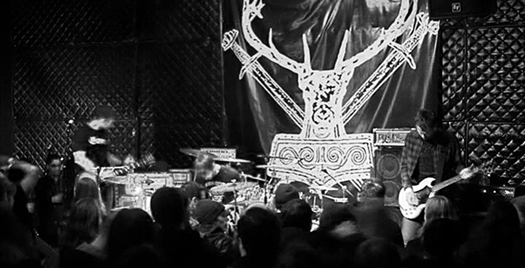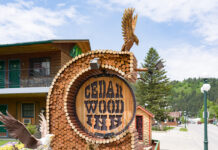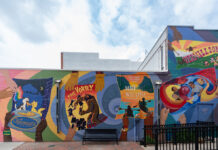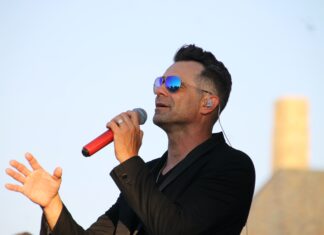Black Hills based metal band, Woman is the Earth, has been carving out their own distinct take on a sub-genre that has seen a recent rise of interest. The band’s 2007 origins found the group as a more thrash leaning outfit in it’s infancy. With a decided desire for a change in direction, the band has chiseled out it’s own unique take on black metal, releasing an early EP followed by three full length offerings over the course of the bands now 10 years together. All Black Hills natives, brothers Andy (guitars) and Jon Martin (drums) are joined by Jarrod Hattervig (drums), and over the years have built a following seeded locally, eventually evolving to a now-international interest.
I recently got the opportunity for a back-and-forth with Andy and Jarrod, discussing the band’s origins, influences, Black Hills roots, vision and finally, their plans for the future, which include a new EP and European tour.
TH: What influences your sound?
JH: We have been largely influenced by the Black Hills and share a general admiration of nature and wilderness. Those influences still play a huge role in our music but we also take inspiration from people, relationships, and personal experiences that we’ve had in life. We also take inspiration from the Dakotas and northern plains in general, how it ties into our family histories, and our Scandinavian ancestries. All those subjects make for great storytelling as well as an opportunity for making music with a lot of emotion.
It may be hard to see the appeal and have appreciation for South Dakota, Rapid City or the Black Hills if a person isn’t from here – but it’s home. It’s a really beautiful and inspiring place if you know where to look. Also, this is where our families are, and we have chosen to start families here, pursue careers and enjoy our relationships here. Our lives outside of music are also extremely important to us.
AM: It’s a nice thing, though, being from South Dakota. There’s not a lot of distractions or trends that come through. I’m sure if you’re in a big city every style and genre has a plethora of bands that are doing it, whereas here, there’s not nearly as strong of a pulse for the genre we play, so you can freely do whatever you want with the sound.
TH: What about your Rapid City home continues to nurture you and compels you to stay put?
AM: I’ve never been that person that just wants to get out of here. I feel like anything I’d want to do somewhere else, I could do here. If you would’ve asked me the same thing when I was younger, I’d have thought different. I was always under the impression that successful art comes from highly populated areas, where culture is diverse and art has a strong presence. Anymore, I wonder if people in those areas are so involved and surrounded with art that they get sort of de-sensitized to what’s going on. In South Dakota, that’s not a problem. The moment you get done playing a show, or practicing, or writing, you’re back to normal life.
TH: How would you describe the current Black Hills metal scene?
JH: We unfortunately don’t get the opportunity to be really involved in the local music scene as much anymore. But we are extremely proud of where we are from and what artists are doing here. I wouldn’t exactly say that the Black Hills metal scene is flourishing, although there are always some really awesome metal projects happening- like the band Souls, and Harhoog, along with hugely influential long running Black Hills bands like Corundum and Dark Nation.
TH: In what ways does it differ from your perspective of the Sioux Falls metal scene?
AM: I know there used to be a big rivalry, but not in a bad sense. I remember hearing about the Sioux Falls scene when I first started going to shows. I heard that a lot of the Sioux Falls bands were more metal/hardcore based. Rapid City was based more in hardcore/punk. They’ve got shows going on more often, and bigger acts going through on that route from Minneapolis to Denver. We’ve had the chance to play in Sioux Falls twice. But, both times it didn’t seem drastically different from Rapid City.
JH: We got a chance to play an East meets West Halloween show with a really cool concept of having some of the best heavy bands from both sides of the state play the same show. That was the first time i’ve had the opportunity to be part of the Sioux Falls metal scene and see some of those bands play live, and it was an awesome night.
TH: You create a unique brand of black metal with your use of atmospheric and more melodic, enchanting sections alongside the more traditional raw and punishing elements of the genre. What pushes you into this musical realm?
AM: It seems like this kind of music can get sterile, especially in recording as well as the live aspect, it can be very synthetic sounding. They have modeling amps now, so you’re not playing out of a tube amp, but a circuit that simulates what a tube amp used to sound like. And the same thing goes with drums, you have widely used drum triggers now. It replaces your real drum with what is actually there. I think leaning too much on these tools can add a non-human element to your music. It can come off as computerized and digital sounding. I think a big part of emphasizing a human-aspect to music is portraying feelings in what you do. The idea of having different vibes in a song or album as opposed to portraying the same feeling over and over. One way that we’ve found to be effective, is to take into account the atmosphere of the music. It’s all about balance though. I could never be in a project where it was always very standard black metal. But, at the same time, I wouldn’t have an interest in doing a project that doesn’t address the more raw aspects of life.
JH: I think the goal and the challenge is to create music that has true emotion, and is also engaging on a technical and musical level. We love heavy, raw, aggressive music but theres so much more to the spectrum of emotion than that. No person is only happy or angry or sad all the time. I hope our music reflects that. The difficult part is making it sound right. Theres a lot of music within the genre that almost seems to flip a switch between being “heavy” or “brutal” and then out of nowhere playing something seemingly a little forced or out of place. It’s a challenge to find a middle ground, but it’s a challenge we are excited to take on and continue to work at.
TH: So how do you then see what you do as unique in a genre that has been slowly been gaining momentum the last three decades?
AM: Trying to see how much further we can push our sound, and which direction to go with it. Trying not to make the same album twice. I have this idea of this music in my head, no concrete example, but an idea that there’s a sound that would be perfect. When we write songs, it’s chasing that sound, and never getting there. Just chasing it and hoping to land on it someday. That idea keeps us motivated and trying new things that we haven’t heard anyone do before.
TH: You have worked with Twin Cities based Init Records on your last two releases. How did you and Steven cross paths and begin working together?
AM: Even though at the time it specifically said on his site, “Currently not accepting demos”, we sent our debut album out to seven different labels that we really liked, Init Records being one of those labels. I’ve asked Steven about all that since. Like, how did he come across our album? He works with some awesome bands. Why would you listen to this demo from a South Dakotan band that no one has ever heard of? He told me that his buddy actually told him about our band (after we sent the album) and he remembered he had the album sitting in his closet and checked it out. He later got ahold of us and wanted to release our next album, 2013’s, Depths. I was thrilled to hear that he wanted to put it out!
He’s been great. He’s never looked at what we’re doing and wanted to change anything about it. There’s a lot of trust on both ends. One thing I like about Steven is that he’s blunt. If you’ve ever met Steven, he tells it as he see it. I like that about someone. You know what they’re thinking and where they stand. Our next record will be an EP called, Thaw, on Init Records. It will actually be a split release between Init and a German label, SickManGettingSick.
TH: What are WITE’s goals for 2017?
AM: We’re going to do a show with Panopticon in April at Hammerheart Brewing. And then, in the summer, we will be touring Europe. Those shows will be in Germany (with our friends in ‘Waldgefluster’), Switzerland, Italy, Croatia, Czech Republic and Austria. After that, we’re scheduled to do a festival in the fall, but it hasn’t been announced yet. Aside from those we usually do two shows in Rapid City each year.
TH: Where do you see the band in five years?
AM: I could very easily see us later on, moving to more of a studio project setup. Which isn’t that far off from how we operate now. We don’t play live a whole lot, but we meet up and work on our music multiple times each week.
JH: I don’t see things changing too much, barring big events in our personal lives. We would like to be able to play a handful of festivals and some tour dates every year, but would likely never be a full time touring band. We just have too much other stuff happening in our lives. But the chance to keep playing and touring with some of our favorite bands and to keep meeting and working with great people is about as good as it gets.
See WITE perform songs from their upcoming Thaw EP at Black Hills Vinyl April 8 for the Howling Embers CD release show. RSVP here.





















